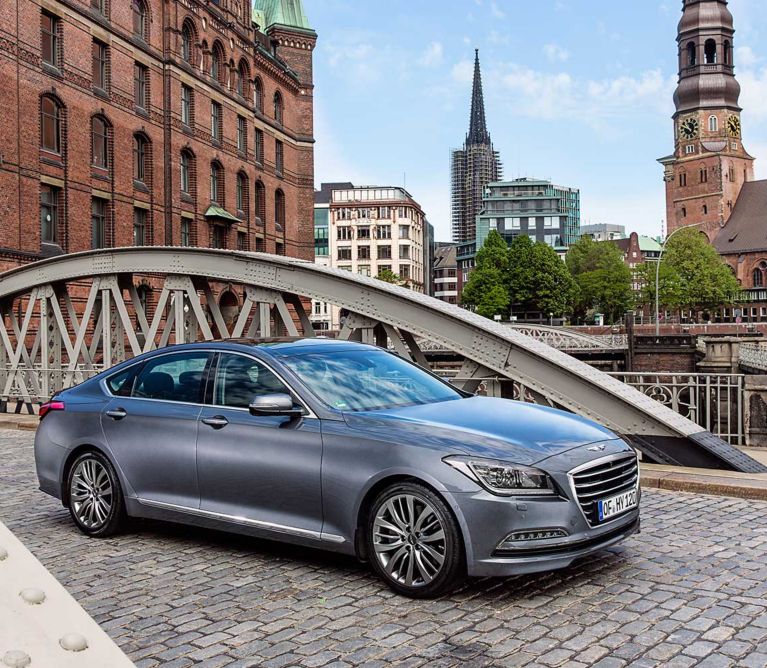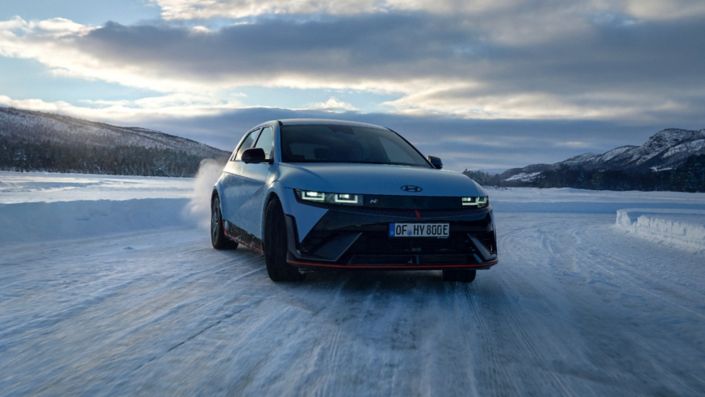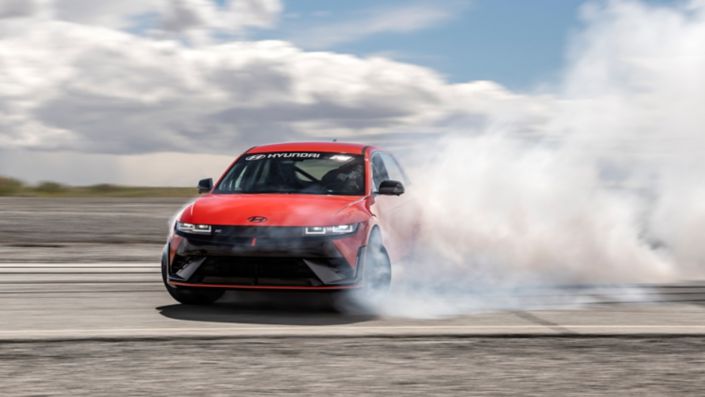- Multi-link front and rear suspension ensures greater driving composure
- Intelligent driving modes suit preferred personal driving preferences and changing road conditions
- All-new platform uses high strength steel and advanced construction to achieve high rigidity
Press material
-
Download
-
Images
All-New Genesis is equipped with Hyundai’s HTRAC all-wheel drive system and multi-link front and rear suspension, ensuring that the plentiful power is transferred to the road even in difficult, slippery conditions, and acceleration and advanced braking performance for driver security and comfort. A near-equal front-to-rear weight distribution (52:48 front:rear) furthers the sensation of security and composure.
The HTRAC system maximises driving pleasure and makes performance accessible in even the most demanding conditions by automatically distributing torque to utilise available grip – aiding acceleration and braking, especially when grip is low.
Underlining Hyundai’s commitment to engineering the right cars for the right global regions, All-New Genesis was developed through extensive on-the-road and laboratory-based trials. Circuit testing of the new model took place in Germany, Korea and at Hyundai’s California Proving Ground in the United States. Extreme G-force assessment of the new HTRAC all-wheel drive system was completed at the Korea International Circuit in Yeongam, built to FIA Formula One standards. Durability and high-performance handling driving tests took place at Hyundai’s European test centre at the legendary Nürburgring Nordschleife circuit in Germany, to precisely fine-tune the cosseting ride of All-New Genesis, as well as refining its reassuring braking and handling characteristics. Final suspension tuning involved Lotus, whose engineers utilised their world-renowned expertise to ensure All-New Genesis delivers both driving control and exceptional comfort.
The use of advanced-high-strength steel allows All-New Genesis to offer a compliant ride that isolates occupants from the imperfections and undulations that are commonly found on European roads. The addition of our new HTRAC all-wheel drive system ensures driving characteristics can be changed to suit driver preferences and road conditions.
New HTRAC AWD system
The All-New Genesis is equipped with Hyundai’s new HTRAC All-Wheel Drive (AWD) system*. HTRAC is a multi-mode system, providing an electronic, variable-torque-split clutch with active torque control between the front and rear axles. In the pursuit of optimal weight balance and driving dynamics, Hyundai engineers produced one of the lightest all-wheel drive systems in use today, at just 75 kg.
An Intelligent Driving Mode allows drivers to select from three operational modes designed to maximise driving security and pleasure in all conditions and for all driving preferences. Each mode alters transmission mapping, power distribution, throttle responsiveness, stability control and suspension damping settings. Selected modes are applied seamlessly by the HTRAC system.
Intelligent Driving Mode: Eco
Driving characteristics: Fuel conservation
Intelligent Driving Mode: Normal
Driving characteristics: Balanced
Intelligent Driving Mode: Sport
Driving characteristics: Dynamic control
‘Normal’ mode helps provide further driver confidence and control in all-weather conditions. The ‘Sport’ setting sends more available torque to the rear wheels for even greater agility with progressive and controllable handling characteristics that are more like those of a rear-wheel drive sedan.
To maximise engine efficiencies, the computer-aided system can direct more available torque to the rear wheels during steady highway cruising to reduce drivetrain friction losses and noise. This system has a wider range of torque distribution variability than many other systems and has been tuned to variable conditions, such as straight-line acceleration, medium- and high-speed cornering, and hill-starts.
New ultra-rigid platform
All-New Genesis sits on a new platform, 51,5% of which is formed from advanced high-strength steel supplied by the world-class Hyundai Steel plant in Korea. The benefits of using more high-strength steel are immediately evident – a 16 per cent increase in torsional rigidity and a 40% increase in bending rigidity. In addition, structural adhesive is applied to 123 metres of major body joints – as a result of these measures All-New Genesis is stiffer in both torsional and bending rigidity than almost all cars of comparable size.
Body and mounting point stiffness has also been improved, ensuring a smooth ride over uneven road surfaces. This was a top development focus for Hyundai’s engineers and they achieved a more robust connecting structure via the extensive use of laser welding, double-reinforced body and chassis mounting points, and a new hot stamping and dipping technique for the B-pillar and roof sides. The new model’s front shock towers are constructed from aluminium rather than steel while a diamond-shaped strut bar maximises front-end rigidity for a more precise steering response. The front seat frames have been also strengthened for greater feeling of rigidity from inside the cabin.
Performance chassis
The stiffer chassis employs a new front and rear multi-link suspension arrangement, with newly optimised geometry for dynamic performance and ride comfort. Lateral suspension stiffness improvements have been achieved by the use of the fully-independent, five-link front and rear suspension design, with increased suspension travel, for greater wheel articulation and bump absorption over a variety of road surfaces. The reduction in camber angles when turning at speed results in improved steering feedback, 23 per cent less tyre flex, and increased lateral grip. Bespoke 19-inch alloy wheels are stronger and offer more precise suspension response across variable road surfaces.
The Continuous Damping Control (CDC) suspension system reduces body motion and roll, allowing a more responsive and dynamic drive complemented with a cosseting ride. Independent roll control is achieved using separate HTRAC modes: ‘Normal’ helps provide a superior ride comfort, while ‘Sport’ mode helps increase damping forces for enhanced dynamic precision and control. Handling and road holding also benefit from the near-equal 52:48 front-to-rear weight distribution.
In addition, special focus was given to the development of the Variable Gear Ratio (VGR) which helps to provide high-speed stability and a more direct feel at low and medium speeds. These driving qualities are attained while retaining the incremental fuel economy benefits of an electric system over the higher parasitic losses of hydraulic systems.
NVH reduction
In the pursuit of optimal refinement and minimal sound intrusion, Hyundai engineers spent considerable time during the development of All-New Genesis to analyse idle noise and vibration; acceleration, road and wind noise; and audible booming throughout the vehicle. Multiple sound-absorbing materials and a low-noise fuel pump have been fitted, bulkhead insulation and sealing improved, and vibrations minimised through the improvement in overall rigidity. Additional rear insulation helps reduce sound boom and vibration, resulting in the lowest possible levels of audible noise (as low as 50 dB when accelerating) inside the soothing cabin.
Under acceleration, improved sound quality has been achieved through mid-to-high-frequency noise reduction, and dynamic engine sound improvements were achieved through intake and exhaust system tuning. Engine support brackets have been moved further apart for greater stiffness, while transmission and sub-frame mounts have been stiffened by up to 100 per cent.
To improve NVH performance at cruising speeds (around 100-190 km/h), Hyundai engineers increased the stiffness of parts associated with the sub-frames and suspension, lowering levels of cavity and rumble noise. To ensure All-New Genesis recorded lower interior noise in crosswind conditions, the doors were thickened, sunroof articulation reshaped, and changes were made to the sealing process for increased durability and performance. In addition, cowl bulkhead insulation and sealing has been improved. In total, just 3 kg of sound insulation is used during production of each All-New Genesis, yielding a remarkable NVH reduction-to-weight ratio.
*For right-hand-drive markets, the All-New Genesis is only available in rear-wheel drive configuration.











